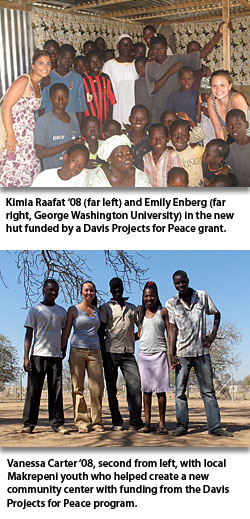 Senior Kimia Raafat had planned to pass out iron skillets, mosquito nets, and chewable vitamins over the summer to orphanages in Senegal where the majority of children under the age of 5 develop iron-deficiency anemia. But arriving in western Africa, the unexpected proved more pressing. Encountering 70 boys on the dirt floor of a cardboard hut, she decided to reprioritize. With its leaky paper roof and walls letting in rain and mosquitoes, the shabby dwelling was conducive to the spread of malaria and needed a safer, more durable replacement.
Senior Kimia Raafat had planned to pass out iron skillets, mosquito nets, and chewable vitamins over the summer to orphanages in Senegal where the majority of children under the age of 5 develop iron-deficiency anemia. But arriving in western Africa, the unexpected proved more pressing. Encountering 70 boys on the dirt floor of a cardboard hut, she decided to reprioritize. With its leaky paper roof and walls letting in rain and mosquitoes, the shabby dwelling was conducive to the spread of malaria and needed a safer, more durable replacement.
Over the next month, Raafat '08 and George Washington University student Emily Enberg rearranged a budget allotted them by Davis Projects for Peace. The skillet distribution would go on the back burner so money could be freed up instead for sheet metal, cement, and wooden pegs to build a new shelter for the boysan expense requiring Raafat and Enberg to sell back some of their mosquito nets.
"We realized they couldn't even be hung from the cardboard walls and the tattered pieces of tarp that dangled above the boys in the existing shelter," Raafat said. "We knew that to prevent malaria and other diseases, a roof to keep out the rain at night was a much bigger priority."
Launched in 2007 in honor of internationalist and philanthropist Kathryn Wasserman Davis, the Davis Projects for Peace program (http://www.kwd100projectsforpeace.org/) encourages and supports students in grassroots, peace-building projects anywhere in the world, particularly those effecting lasting, sustainable change within a given region or community.
Claremont McKenna is among the select schools eligible for Projects for Peace funding. Qualifying campuses are allowed to submit one proposal, plus one alternate; the 100 projects judged to be the most promising and feasible are funded for $10,000, from which students draw their travel expenses and all other related project costs.
This is the second year that CMC student projects have been awarded Davis grants, and the second time that Projects for Peace funded a primary and alternate proposal submitted by CMC. In addition to Raafat's "Iron Man" work in Dakar, Senegal, last summer, graduated senior Vanessa Carter '08 also was given money to create a newer, safer community center in Makrepeni, in the Manyeleti region of Mpumalanga, South Africa, where local women and youth could hold meetings and coordinate programming on such topics as malaria, tuberculosis, diarrhea, malnutrition, and HIV/AIDS.
View photos of Raafat's and Carter's visits to Africa for Projects for Peace.
It was Carter's second trip to South Africa. Last summer she helped build two libraries and repair a daycare center.
"CMC helped prepare me for my South Africa experience in 2007 because of the amazing grant support from The Center for the Study of the Holocaust, Genocide, and Human Rights, as well as the McKenna International Internship award," Carter said. "It was during my work in South Africa last summer that I identified the project that I proposed to Davis Projects for Peace. Without that experience I could not have made the contacts and acquired the skills to complete my proposal."
A major lesson learned this summer for Carter is that time for development work is never long enough. "A significant amount of energy must be spent getting to know the community and local customs and norms," she says. "Secondly, the work is never finished. There is always more to do in an impoverished community."
It was a similar lesson for Raafat and Enberg, switching from Plan A to Plan B once they encountered the immediate needs of the young men and boys in their cardboard shanty. As young as 4, boys are routinely sent by impoverished families that can't afford private Koranic schooling to a daara ("Koranic School") to memorize the Koran. The number of boys in any particular daara can run from 50 to 100, Raafat and Enberg say.
"The responsibility to support and care for a group that size is nearly impossible," Raafat says. "So every day, the boys are sent to the streets to beg for money, sugar, riceanything."
In the pair's original, winning proposal, Raafat and Enberg planned to combat the preventable problem of micronutrient malnutrition in Senegalese childrenthe inadequate availability of some essential nutrients that the body needs in small quantities, such as iodine, iron and vitamin A.
"When I heard I'd been selected for a Projects for Peace grant, it was surreal," Raafat says. "I was excited and anxious. We were given first-hand exposure to the struggles, realities, and culture in Senegal. By focusing on orphanages we had hoped to help prevent iron deficiency among large numbers of children. We believed that the physical well-being of these young children would allow them to lead more peaceful lives."
But Raafat says the decision to fund a new shelter instead was the right one. "Every day as we drove away, we were touched by the crowd of kids chasing our car, waving thankful goodbyes," she says.
For a complete list of participating schools, as well as summaries of 2007 and 2008 Davis projects, visit: www.davisprojectsforpeace.org.
Davis Projects for Peace Program
Funds Student Work in Africa
Topics
Contact
Office of Strategic Communications & Marketing
400 N. Claremont Blvd.
Claremont, CA 91711
Phone: (909) 621-8099
Email: [email protected]
Media inquiries: CMC Media
Email: [email protected]
